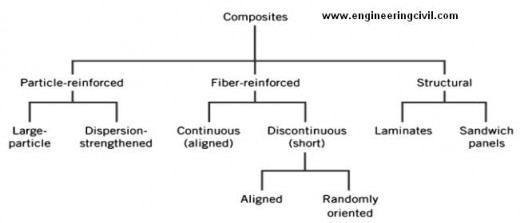Sreenivasa Hassan Jayaram
Manager-Projects, Jones Lang LaSalle India, Bangalore, Karnataka, 560001
Abstract-Composite materials are combination of two or more simple materials to yield another material with better properties like higher strength, stiffness, fatigue life, less weight, Resistance to higher temperatures. The common types of Composites under use are Particle reinforced type, Fiber reinforced type, Sandwich or Laminated type.In composites normally particle of one or more material are suspended in a matrix of another material to make the material stronger. The Fiber Reinforced Composites are the long fiber of one material is embedded in the matrix of other material which turns out to be extremely strong. The fiber reinforced composites can be used in concrete by reinforcing elements like carbon fiber, aramid fiber, grid type reinforcement elements, etc. Add reinforcing steel rods, wires and bars (rebar) to uncured concrete to enhance mechanical strength. The environmental effects on this composite material may pose threat to structure and must be considered during the design process, otherwise failure will cause waste of time, energy and money. Usually the degree of sensitivity of composites to individual environmental factors is quite different. The effects of environmental factors such as biological attack, fatigue, temperature and moisture can limit the usefulness of polymer composites by deteriorating the mechanical properties during service and are the most important environmental degradation factors to be taken into consideration. The temperature effects on the fracture properties of composites. The study by Marom, 1989[7] showed that inter laminar fracture energy decreased by 25-30% as temperature increased from –50°C to 100°C. All these factors are particularly significant in tropical and subtropical conditions, cracking of elements may cause rapid of degradation by corrosion. The paper highlights the effect of environmental parameters on performance of various types of composites with necessary precautions.
INTRODUCTION:
Composite materials are multiphase materials obtained by artificial combination of different materials, so as to attain properties, like higher strength, stiffness, fatigue life, less weight, Resistance to higher temperatures, which the individual components by themselves cannot attain. The concept of improved performance is broad and includes increased strength or reinforcement of one material by the addition of another material, as well as increased toughness, decreased coefficient of thermal expansion, and increased thermal or electrical conductivity.
Another example is concrete, which is a structural composite (as used for highways) obtained by combining (through mixing) cement (the matrix, i.e., the binder, obtained by a reaction, known as hydration, between cement and water), sand (fine aggregate), gravel (coarse aggregate), and optionally other ingredients that are known as admixtures. Short fibers and silica fume (a fine SiO2 particulate) are examples of admixtures.
TYPES OF COMPOSITES:
Composites can also be classified according to the geometry as Particle reinforced, Fiber reinforced, Sandwich or Laminated type. The tree diagram and its brief definition are given in Table 1.
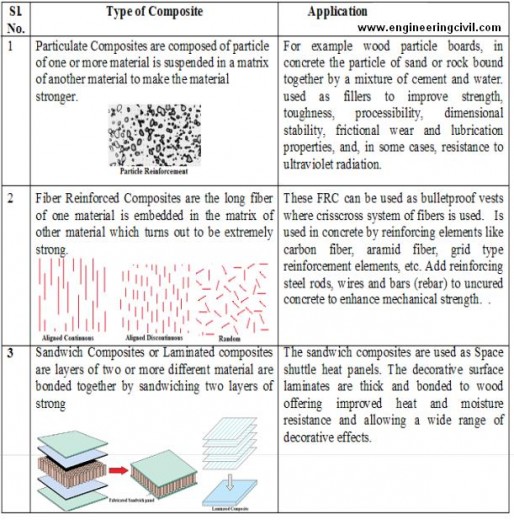
Table1: Types of Composites and its application
The very first known application of fiber composites was in construction. Straw reinforced clay bricks were used by the Egyptian Pharaohs, Israelites and Chinese centuries ago. Nowadays the construction is the field of greatest application of fiber composites. The property of composites of being strong and resistant to environmental impacts makes them good building material.
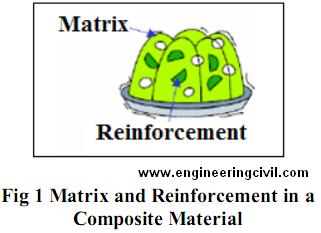
ENVIRONMENTAL EFFECTS ON COMPOSITES:
Composite usage has increased enormously mainly due to the advantages of lightweight, specific strength and stiffness, dimensional stability, tailor-ability of properties such as coefficient of thermal expansion and high thermal conductivity. Environmental effects on these properties may compromise a structure and must be considered during the design process.
Environmental effects on composite materials have to be considered in the early stages of design or the design iterations and failure will cause a waste of time, energy and money. Usually the degree of sensitivity of composites to individual environmental factors is quite different. The effects of environmental factors such as biological attack, fatigue, temperature and moisture can limit the usefulness of polymer composites by deteriorating mechanical properties during service and are the most important environmental degradation factors taken into consideration.
The temperature and moisture are the most important environmental degradation factors taken into consideration. The study shown that their combination has more aggressive effects on the properties of composites than each alone, and the failure mode can also be changed at high temperatures under moisture conditioning. The primary environmental effects are on the matrix phase and possibly the interface, while the fibers are usually relatively insensitive in the range of conditioning for polymer matrix composites.
BIOLOGICAL ATTACK
Biological attack on composite materials may consist of fungal growth or marine fouling. Fungal growth does not appear to be as damaging as the wet conditions that promote growth. Fungicide has been mixed in with resins to retard this growth. Even though marine organisms will grow on composite surfaces, mechanical properties do not appear to be affected and the fouling can be removed by scraping. Composites with graphite fibres have been used in medical applications for both internal and external purposes. Internal composite structures such as artificial joints or plates for bone fracture support must be bio-compatible or the material may degrade over time. External composite designs (such as artificial limbs or orthotic braces) may experience impact damage, flexural and torsional loading during use.
There is a possibility of bacterial and fungal attack on semi-moist and in alternate wetting and drying conditions. The effect on strength of composite material due to cyclic wetting and drying (Biological attack) is studied on composites with natural fibres (Fig.2). The graph shows considerable decrease of strength of composite material with the biological attack occurring at the water-air interface. The degradation of composite material due to biological factors also depends on the chemistry of composites which can be either alkaline or carbonic.
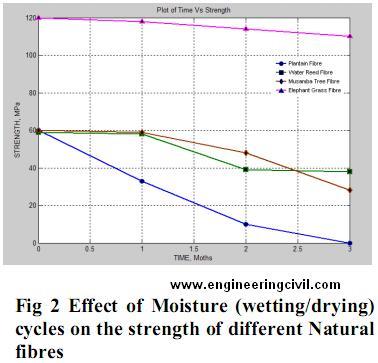
MOISTURE PENETRATION
Composite material components are subjected to a wide range of environments. Environmental factors of major importance include a combination of moisture and temperature. Moisture is present in the operational environment in which a composite is manufactured and throughout its useful life. Water acts as a plasticizer when absorbed by the matrix, softening the material and reducing some properties of the laminate. Moisture may also migrate along the fiber-matrix interface (fig 1) thereby affecting the adhesion. Moisture in composites reduces matrix dominated properties such as transverse strength, fracture toughness and impact resistance.
Lowering of the glass transition temperature may also occur in epoxy and polyimide resins with an increase in absorbed moisture (as shown in Fig 3). Debonding can occur due to formation of discontinuous bubbles and cracking in the matrix. Mechanical properties can be reduced even further if heat is present or if the composite is under-cured or has a large amount of voids. Composite materials offer high corrosion resistance. Iron and aluminum corrode in the presence of water and air and require special coatings and alloying. Because the outer surface of composites is formed by plastics, corrosion and chemical resistance are very good.
Moisture is absorbed into the composite until a saturation point is reached. This has been described as a non-Fickian process, meaning the rate of relaxation in the material due to water absorption is comparable to the diffusion rate of water. As the material properties change, such as decrease in glass transition temperature, the diffusion process changes. The mechanical properties degrade in relation to the amount of moisture absorbed, with no further deterioration after saturation is reached. Strength reductions in polyester laminates have been found to be 10-15% while epoxy resins are less vulnerable.
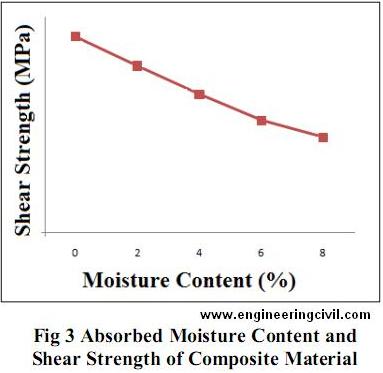
It must also be clearly understood that the transport of moisture in to the body of the composite, which depends on the free volume available in the body of the epoxy matrix also depends on the segmental mobility. The composite components so engaged experience repeated absorption/desorption of moisture in a wide range of humidity and temperature conditions based on the location of composite and environment.
The properties of composite materials are susceptible to changes induced by the take-up of moisture. Moisture absorption can occur during production and under use of components. Desorption occurs in vacuum. The mechanisms for entry of water into the composite material include diffusion, capillarity along the fibers, the interface and transport by micro-cracks as per Loos et al. (1981)[5]. The moisture accumulation at the fiber-matrix interface causes de bonding and thus substantially lowers the shear strength of the composite, the moisture may also induced swelling of the epoxy matrix around the fibre reduces the residual compressive stresses at the interface caused by shrinkages during curing.
The primary mechanism of moisture pick up by the FRP composites is surface absorption and diffusion through the matrix is given by Fick’s second law of diffusion. The water absorption behavior is affected by two competitive processes
1) Hydrolysis, which tends to subtract water to the diffusion process and 2) Hydrophilisation, which results in increased uptake of water through swelling and plasticization, these changes decrease glass transition temperature Tg and elastic modulus.
In order to rationalize these effects, a stress corrosion cracking based model is currently developed to predict damage accumulation within the material under the combined effects of stress and water ageing. The changes in the density of broken fibers are quantified as a function of time under static fatigue loading in a water environment and at different temperatures.
The different behavior of the two polymeric matrices studied and changes in the distribution of relaxation times associated with the glass-transition (Tg) could not have been caused only by the plasticization effect because the specimens were submitted to the same hygrothermal conditioning before the DMA tests. Other possible explanation for the change in the relaxation time distributions involves a specific evolution of the macromolecular network at the fiber/matrix interface and/or debonding during the hygrothermal conditioning.
Although it is not possible to identify these processes from a chemical point of view, it is possible to conclude that these processes affect the interface sufficiently to modify the relaxation mechanisms associated with the glass-transition. The movement of the polymeric chain is more difficult for higher interface adhesion. Therefore, the interface adhesion increases the Tg. Since the environmental conditioning reduces the Tg, it is expected that the interface adhesion be also reduced. This hypothesis is established by Inter-laminar Shear Strength (ILSS) measurements that decrease with moisture absorption. The variation of ILSS as a function of environmental condition is shown in figure 4.
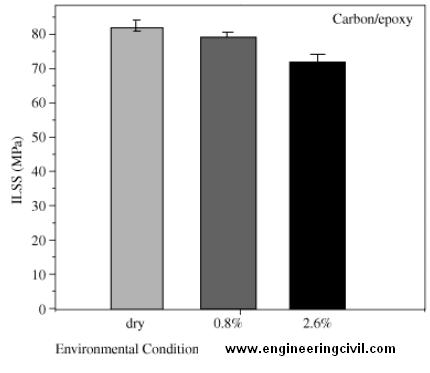
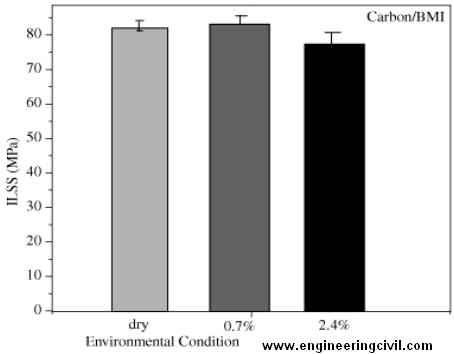
Fig 4 Environmental factors Vs Shear strength for Carbon Epoxy fabric/BMI composites
Many studies have been conducted to investigate moisture absorption and the reduction of mechanical properties due to temperature and moisture exposure. The current approach used to account for environmental factors defines extreme exposures and selectively evaluate the effects of such environments on material properties by test. These extremes are then considered to be invariant during the lifetime of the structure.
Strength values are then reduced to coincide with the environmental extremes. Figure 5 is a graphical schematic of strain-based design criteria, which shows the applied loading factors as separate functions of moisture and thermal loading effects. The approach employed in this is to characterize these differences in thermal and moisture factors as typically used in design and certification testing, as well as to include the building-block effect, which shows the scaling effect related to this design criterion.
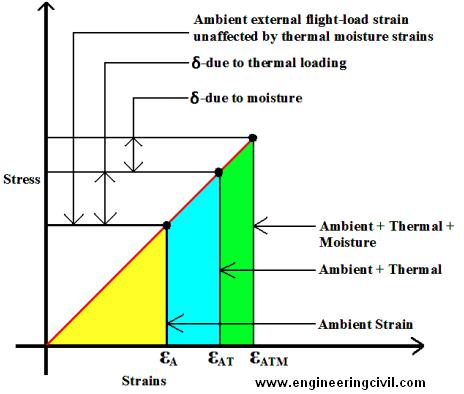
Fig 5. Effect of Environmental factors on Stress-Strain Diagram of composite Material
The moisture gradient in a composite is responsible for the generation of compressive stresses in the outer ply during absorption and similarly tensile stress is generated during desorption. The polymer micro-molecules, forced apart by the absorbed moisture cause the FRP composite to expand or swell. This phenomenon apart from affecting the fibre matrix adhesion resulting in de bonding of the interface and generating micro cracks in the composite, causes an increase in the chain separation which causes a reduction in the secondary intermolecular bonding forces in the polymer itself. As a consequence the material becomes softer and more ductile. In this condition if the ambient temperature is also decreased the apparently strong matrix housing the fiber becomes rubbery and weak.
Creation of Moisture barriers: Silane Coatings can be used to prevent moisture absorption or desorption of dimensionally stable structures made of composite material to prevent the release of organic volatiles which could affect the performances of some equipments.
Effect of Weathering on Composite Material:
Warm, moist climate may affect the performance of composites. Decrease of 10-20% in tensile strength has been noted for fibre glass/polyester and fibre glass/epoxy where the surface resin has been eroded away due to extended weathering. Erosion due to rain, snow or ice impact may be a problem for some aircraft parts, such as radomes or leading edge parts.
Coatings such as polyurethane may be used to make composite parts more resistant to this type of erosion. Effect of weathering on composites depends on the type of material used and whether a protective coating was intact. Studies have indicated that where the paint was intact, the material retained more than 90% of its original strength and 80-90% of modulus. Where the paint had been eroded away, the composite retained only 68% of its original strength.
Composite components are required to qualify the moisture tests, which broadly include condition of structure before and during static and fatigue tests by moisture saturation. Static tests are carried out following immersion of composite parts in fluids like fuel, hydraulic fluids, cleaning agents, de-icing fluids, etc.
TEMPERATURE EFFECTS ON COMPOSITE MATERIAL:
Temperature effects on composite materials include cryogenic temperatures, elevated temperatures and thermal cycling between these extremes. Cryogenic temperatures do not appear to affect the mechanical properties of graphite/epoxies or graphite/polyimides significantly. However it makes the composite material relatively brittle and decrease in shear strength. Elevated temperatures for a prolonged period of time can seriously affect the properties of a composite, with even greater effect if moisture is present. There will be a loss of stiffness with the increasing in temperature and ageing. Susceptibility to matrix softening is not only dependent on the resin but also the lay-up. Temperature effects are not limited to the matrix materials. Extended operation at 350°C and 450°C can cause oxidation of low modulus PAN-based fibres and high modulus PAN- or Pitch-based fibres, respectively. Oxidation resistance can be improved with higher purity fibres. Thermal cycling conditions are common for a number of applications, including aircraft and spacecraft. Thermal cycling may induce micro cracking in some composites thereby resulting in reduction of compressive and shear strength.
At a certain value of the temperature the matrix materials transitions from a glass-like behavior to a rubbery behavior. Protection against temperature effects can be achieved at the design stage itself by:
• Selection of resin system with high glass transition temperature.
• Potential degradation taken into account in the analysis and fatigue test.
• Protection against moisture exposure.
Overheat Conditions, heat generated by lightning strikes has been known to vaporize matrix resins and create large areas of de-lamination and fibre fracturing on composite rudders, ailerons, wing and stabilizer tips, nose domes and nacelle cowling. When exposed to hot gases over long periods, polymeric resin binders can become completely destroyed through a process of thermo-oxidation. Preventive methods may consist of application of heat resistant ablative coatings.
Composites may be exposed to low temperature conditions (-20oC or below) or high temperature conditions (50oC or above) in their 30-year service life. Exposure to low temperature of some tough polymers may make them more brittle and the modulus may increase. It has been reported that the temperature effect on the fiber-matrix interface is as strong as those of the fiber treatment and resin properties. Other mechanical properties such as compression strength, ultimate tensile strength, and tensile strength (which is matrix dominated) have also been reported to decrease at elevated temperature. Temperature effects on the fracture properties of composites were widely investigated by Marom [7]. The study showed that inter-laminar fracture energy decreased 25%-30% as the temperature increased from -50oC to 100oC. The inter-laminar fracture surface characteristics of graphite/epoxy were also investigated and pronounced differences were observed in the amounts of fiber/matrix separation and resin-matrix fracture with increasing temperature. The temperature effect on the mechanical properties of composites derives partly from the internal stresses introduced by the differential thermal coefficients of composite components. Such internal stresses change magnitude with temperature change, in some cases producing matrix cracking at very low temperatures. In practical applications each polymer has its own operating temperature rage. Usually a polymer has a maximum use temperature slightly below its glass transition temperature (Tg), (fig 6) at which the polymer transfers from rigid state to rubbery state and suffers substantial mechanical property loss. Elevated temperatures combined with humid environments have been found to exacerbate the problem by further reducing Tg, among other factors.
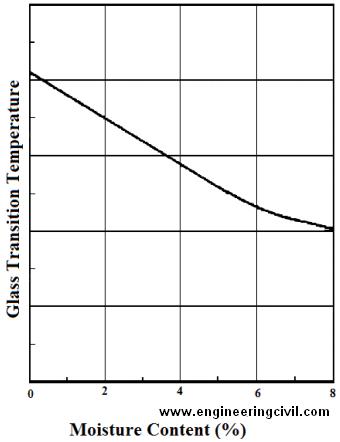
CONCLUSION:
The performance characteristics of composite mentioned under various environmental conditions are discussed. The change in temperature and moisture intrusion decreases the shear strength and increase the strain energy of the composite material (fig.5). The biological agents like fungi, insects, and micro organisms accelerate the disintegration of the composite material.
Moisture absorption can occur during production and under use of components. Desorption occurs in vacuum. The properties of fibrous composite materials are susceptible to changes induced by the take-up of moisture from the atmosphere. The performance of various fibres is found to vary depending upon the temperature and %moisture content (fig. 2). The stiffness along the fibers is linearly depends on the fiber volume fraction. Thermal cycling can induce thermal stresses and due to difference in coefficient of thermal expansion between fibres and matrix (fig. 1) for composites and between base metal and coating micro-cracks can form which could jeopardise long-term properties. Protective coatings have been suggested depending upon type composite material and environment for increasing the
resistance of the material.
REFERENCES:
[1] S. J. Dastin and others, Determination of Principal Properties of “E” Fiberglass High Temperature Epoxy Laminates for Aircraft, Grumman Aircraft Engineering Corporation, DAA21- 68-C-0404, August 1969.
[2] Department of Defense Handbook Composite Material Handbook Volume 2 POLYMER MATRIX COMPOSITES MATERIALS PROPERTIES
[3] Valery V. Vasiliev and Evgeny V. Morozov Advanced Mechanics Of Composite Materials Elsevier, Boulevard, Langford Lane, Kidlington, 2007.
[4] B C Ray Impact of Environmental and Experimental Parameters on FRP Composites, Eighteenth International Symposium on Processing and Fabrication of Advance Materials, SENDAI, JAPAN December 12-14, 2009
[5] Alfred C. Loos., “ Introduction to Composite Materials” Department of Mechanical Engineering, Michigan State University, East Lansing MI 48824-1226.
[6] Mei Li., “Temperature And Moisture Effects On Composite Materials For Wind 6-542.
Turbine Blades”, Thesis Report Montana State University-Bozeman, Montana, March 2000
[7] Marom. G., “Environmental Effects on Fracture Mechanical Properties of Polymer Composites”, Application of Fracture Mechanics to Composite Materials, edited by Friedrich, K., 1989, pp. 397-423.
[8] Cai, L.-W., Weitsman, Y., “Non-Fickian Moisture Diffusion in Polymeric Composites,” Journal of Composite Materials, Vol.28, No. 2, 1994, pp. 131-151.
[9] Schultheisz, R.C., McDonough, G.W., Kondagunta, S., Schutte, L.C., Macturk, S.K., McAuliffe, M., Hunston, L.D., “Effect of Moisture on E-Glass/Epoxy Interfacial and Fiber Strengths,” Composite Materials: Testing and Design, Thirteenth Volume, ASTM STP 1242, 1997, pp. 257-286.
[10] Hale, J.M., Gibson, G.A., “Coupon Tests of Fibre Reinforced Plastics at Elevated Temperatures in Offshore Processing Environments,” Journal of Composite Materials, Vol.32, No.6 / 1998, pp. 52
We at engineeringcivil.com are thankful to Sir Sreenivasa Hassan Jayaram for submitting his research paper on “Impingement Of Environmental Factors That Defines A System On Composites Performance.” to us. We are sure this will be very useful to researchers as well as students who wish to learn more about Factors affecting composite materials.
If you have a query, you can ask a question here.



